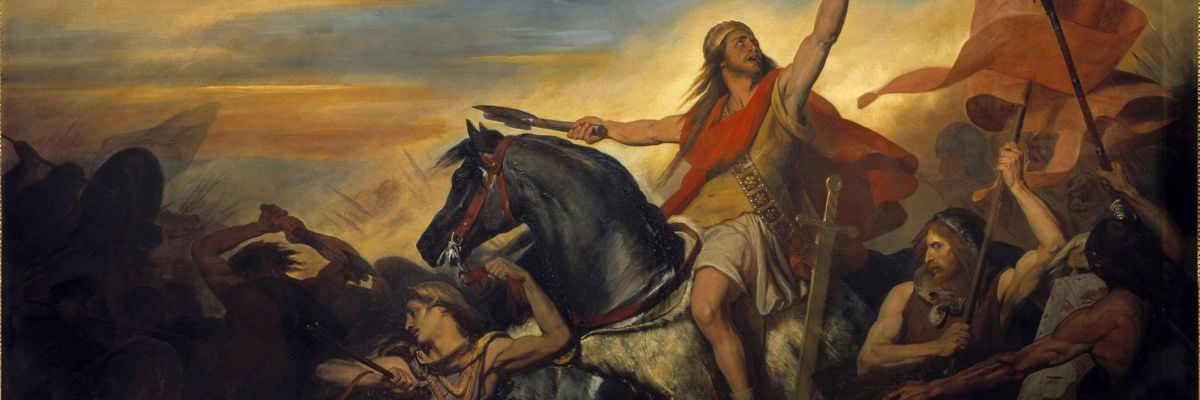
At the end of December, A.D. 406, a massive host of Germanic tribes, including the Vandals, Alans, and Suevi, poured across the frozen Rhine River and broke through the ancient Roman forts and defenses called the limes Belgica that had long served as a frontier between the Roman Empire in the West and the barbarian lands beyond. Crippled by the steady decline of imperial power, the Roman government in the provinces of Gaul (modern France) could do little to resist, and over the next years Germanic tribes roamed virtually at will across Gaul and the western provinces. As the different tribes settled in parts of the empire, Western Europe ceased to be the land of Roman civilization but became instead a crude patchwork of Germanic kingdoms.
The area south of the Loire was divided between two tribes. The Visigoths—best known for their eventual sack of Rome in 410—occupied Aquitania, Provence, and most of Spain. The other tribe, the Burgundians, took over most of the Rhône Valley and laid the foundations for the famed medieval Duchy of Burgundy. In northern Gaul, the tribes of the Alamanni occupied Alsace and moved westward into the area between the Franks and Burgundians, while the first British immigrants established themselves on the Armorican Peninsula (now Brittany). A pitiful territory that continued to call itself Roman remained within these areas of Gaul, and an imperial claimant, Syagrius, was placed in Soissons and shared power with the local bishops.
In the face of the invasions, the Church in Gaul was confronted with many of the same difficulties as the communities elsewhere in the West, including the disappearance of local Roman authority and the emergence of violent barbarian kingdoms built upon the remains of Gallo-Roman civilization. Of the surviving institutions of Roman imperial society, however, only the Church in Gaul was positioned ideally not merely to endure but to influence those who claimed supremacy over the fallen empire.
The history of the Church is filled periods in which the Church has stood as the last vestige of civilization, of light, and of hope. Gaul in the early fifth century was just such a time.
Defenders of the City
Since its introduction into the Gallic provinces—there was a Christian community in Lugdunum (modern Lyons) from around 177—the Christian faith had spread steadily in the cities, so that by 250 there were some 30 episcopal sees, and by A.D. 400 virtually every town or large community was governed by its own bishop. At the same time, the bishops in the cities had been forced to serve also as civil leaders, filling the administrative roles abandoned by imperial Roman officials. Bishops such as Sidonius Apollinaris, Avitus, Germanus of Auxerre, and Caesarius of Arles were viewed as defensores civitatum (defenders of the city). They maintained order in the civitates and were spokesmen and trustees for the patrimony of the bankrupt empire to the reges crinite, or “long-haired kings.” Indeed, the bishops in many instances were all that stood between the violent Germanic tribes and the defenseless citizens of a now-dead empire.
What followed was a relationship of necessity between the bishops and the Germanic chieftains. For their part, the barbarian rulers needed the bishops to speak to their new subjects, to have some connection to the past, and to find a way to administer even rudimentary government. The bishops, meanwhile, had to work with the new overlords to protect their frightened people and safeguard Church property, as only the German kings and chieftains could keep their warriors in line.
The bishops assumed key posts in the nascent royal regimes as judges, advisors, diplomats, and administrators. In so doing, they guaranteed the security of the Church, created the opportunity to influence directly the development of post-Roman institutions, and served as intermediaries between the old Roman culture and the new order. All this they did without compromising religious principle.
Kingdom of the Franks
In the immediate wake of the invasions, the Christians of Gaul confronted not only the final demise of imperial government and order, but persecution by the conquerors. The Germanic tribes, chiefly the Goths and the Vandals, had been converted to Christianity through the Arian missionary Ulfilas. They were hence adherents of the Arian heresy that had so troubled the Church in the fourth century. Once in control, the tribes sporadically persecuted orthodox Christians. They confiscated their lands, expelled bishops, and installed Arian liturgies. This persecution gradually eased, however, as the Germans began to assimilate and to conform to the only true civilization that any of them had ever encountered, that of the Romans. Wherever possible, the bishops negotiated a policy of moderation, such as at the Council of Agde for Visigothic Gaul in 506, but the Arian ascendancy under the Germanic tribes remained a lingering problem for the orthodox Church. The solution rested not in a resurgence of Roman imperial suzerainty but in the conversion of the barbarians. Indeed, the last significant Gallo-Roman official, Syagrius of Soisson, was defeated in 486 by the rising Germanic power in northern Gaul, the Franks.
Following the invasion of Gaul from 406-07, the Salian Franks settled in Toxandria and distinguished themselves among their Germanic counterparts by their continued adherence to paganism. They had settled initially east of the Rhine and gradually extended their influence into Germania.
They soon extended beyond Toxandria, and by the second half of the fifth century, their chieftain Childeric was described by Bishop Remigius of Rheims as de facto leader of the area of Belgica Secunda (modern Belgium). After Childeric’s death around 481-82, leadership fell to his son Clovis. He consolidated swiftly the position of the Franks in northern Gaul and then expanded his influence southward and along the Rhine at the expense of the Alamanni and the Ripuarian Franks. By the start of the sixth century, the Frankish domain stretched from Soisson to the Visigothic and Burgundian kingdoms in the south.
Clovis the Catholic
Soon after his accession at the age of 15, Clovis received a letter from Bishop Remigius with advice on how to rule, a communication that forecast the interest of the bishops in the new pagan ruler. In his History of the Franks, Gregory of Tours recorded the process of Clovis’ eventual conversion, placing the chief impetus for his embrace of Christianity with his wife. Clotilde was a Burgundian princess and a Catholic who had insisted that the first of their children be baptized. Clovis embraced orthodox Christianity also through the influence and examples of the bishops and Catholic subjects, but Clotilde had the major role. Bishop Nicetus of Trier confirmed her decisive role in a letter dated around 565 to Clovis’ granddaughter, Chlodoswintha. In it he wrote that Clotilde led her husband to the faith, although, “because he was a very shrewd man, he was unwilling to accept it until he knew it was true” (J.N. Hilgarth, Christianity and Paganism, 350-750. The Conversion of Western Europe, 76-78). It is also likely that Clovis wished to identify himself with the Roman provincials—the Catholics—who were his subjects. Their faith was seen as the repository of Romanitas in a way that the Arianism of the Goths was not.
The baptism of Clovis took place either at Rheims or Tours in 496 or 498. Aside from the report that he was baptized with 3,000 of his warriors—he did not compel his followers to do so—what made the baptism so significant for the Church in Gaul was that he had converted to orthodox Christianity. The Church in Gaul henceforth had a patron and champion. The royal baptism began a steady conversion of the Frankish people, hastening their fusion with the Gallo-Roman Catholics. At the same time, the numerous bishops of Gaul celebrated Clovis as their own son, and what had been reluctant and cautious cooperation with the Franks grew rapidly into open and enthusiastic support. In addition, Frankish sentiment increased among the Catholics of southern Gaul and gave them encouragement to begin working toward the defeat of the Arian kingdoms.
In 507, Clovis defeated the Arian Visigoths at Vogladensis (Vouillé), near Poitiers, shattered Visigothic power in southern Gaul, and drove them out of Aquitania beyond the Pyrenees. He then established Lutetia (Paris) as his capital, and in 507-08 received the title of consul with the right to use the imperial insignia from the Eastern Emperor Anastasius in Constantinople. Bishop Avitus expressed what Clovis’ campaigns meant to the orthodox Christians: “Your faith is our triumph. Every battle you fight is a victory for us” (Avitus, Epistulae ad Diversos, 46).
The inevitable success of orthodox Christianity in Gaul under the Merovingian Dynasty was assured through Clovis, who took as his model Emperor Constantine the Great. Clovis was generous to the Church and, like Constantine, crafted for himself a position as protector, convoking a council for Gaul in 511 that hastened the conversion of the Arian clergy, especially in Aquitania. He also specifically mentioned his conversion in the prologue to the Pactus Legis Salicae, the law code for the regnum Francorum that had been drafted with the close consultation of the bishops.
After Rome, Renewal
After the death of Clovis in 511, the succeeding Merovingian kings continued to favor the Frankish Church, which enjoyed tax exemption, with the right to taxes and tithes of its own. Other gifts included massive land grants, so that by the start of the eighth century the Church owned almost one-third of the Frankish kingdom. The Franks, unlike the Goths, willingly intermarried with the peoples they governed. So, as heirs to the Roman authority, they created a mixed culture, with vulgar Latin as the common tongue and Catholic Christianity as the unifying faith.
The long-term consequences of the formation of the regnum Francorum for the Church were seen in several ways. There was for the first time in over a century a Catholic power in the West, one that gradually served as a counter-balance to Constantinople and a broader champion for the Western Church in general and the papacy in particular. The relationship climaxed in 800 with the coronation of the Carolingian Charlemagne as emperor by Pope Leo III in Rome.
At the same time, the advance of the Frankish kingdom into pagan lands to the north and east opened opportunities for evangelization or the re-Christianization of those regions where the faith had been expelled or reduced. Finally, the Franks encouraged the monastic movement, which was, thanks to the zeal of the monks, the primary means for the spread of Christianity across the rest of Europe.
And so, chiefly because of the Church, civilization was born anew in the lands that had been the cemetery of the Western Roman Empire. Without the Church and her bishops and faithful, the history of the West might have been very different, a lesson for Catholics today who might doubt the Church’s role in what many are calling the 21st century’s post-Christian Europe. Historian Robert Markus provides a concluding thought on the role of the Church in the transformation that took place in Gaul in the two centuries following the collapse of Roman power:
Though it still needed to learn to live with the ways of the new peoples, it had its own mature traditions and cultural and institutional development, encapsulating much of Roman civilization and fitting to play a decisive role in shaping the new Germanic societies. If the characteristic stance of Christianity in the Roman world was that of learning, its characteristic stance in the Germanic West was that of teaching. (Oxford Illustrated History of the Christian Church, 62)



